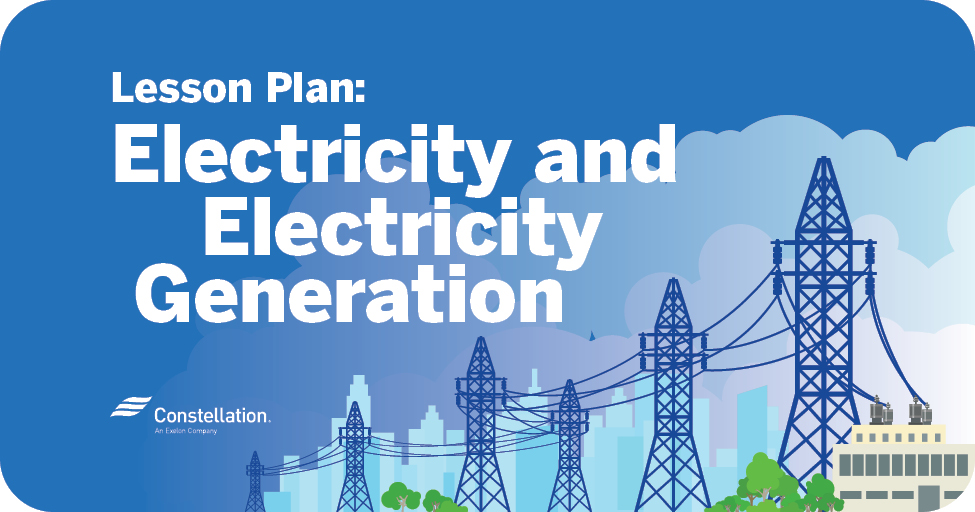This lesson aims to introduce students to the basics of electricity – what it is, how we use it, and how we can generate it. Electricity is most often generated using a generator. Generators use motion energy and electromagnetism to generate the electricity that powers much of our homes. Students will begin to explore how electricity and magnetism are related to begin to think about how generators work!
For each suggested grade band, you’ll see some quick text for reading as well as a worksheet or link to interactive worksheets. For all four grade bands, there will be one challenge/hands-on activity to complete that supports the theme of the content. These hands-on pieces can absolutely be completed as a family or with multiple students of various grades. We also have listed links to additional content. If your student is advanced, or needs more support, feel free to scale up or down within the levels, or encourage them to complete multiple activities from the different levels.
Looking for more home energy activities? We’re pleased to work with The National Energy Education Development Project (NEED), to deliver these fun activities. Be sure to check out their library of resources, and their specialized collection of energy-themed distance/at-home learning activities. All activities are totally free for use at home or school, and accessible by visiting their website, www.NEED.org.
- Background reading: Primary Energy Infobook, Electricity
*Primary reading is structured with the student reader page first, and the teacher/adult page second. Younger or less advanced readers can read along with the student pages, and the teacher pages may be read aloud to them. Advanced readers may be able to read most on their own.
- Printable Worksheet: Primary Energy Infobook Activities, Electricity Works for Me
- Background reading: Elementary Energy Infobook
- Interactive worksheets:
- Background reading: Intermediate Energy Infobook, Electricity
- Interactive worksheet
- Background reading: Secondary Energy Infobook, Electricity
- Interactive worksheet
- Electromagnets is a fun way to show students how electricity from a battery can make a metallic item into a magnet – demonstrating that electricity and magnetism are related! For this activity, you’ll be using a battery, some coated wire or an alligator clip to make an electric circuit, and a nail with a compass to demonstrate magnetism. Use caution: the battery may become warm to the touch while the wire is connected.
Alternative
Don’t have a compass? Want an extra challenge? Grab a few paperclips and place them near the nail as an alternative method to demonstrate that you have a magnet. If the nail is magnetized it will pick up the paperclips! How many can you lift?
Background Information for adults:
This activity takes a non-magnetic object, a nail, and makes it magnetic. Ordinarily, iron is not in and of itself a magnet, but it will respond to a magnetic field. Only three metals are noticeably magnetic: iron, nickel, and cobalt. This is related to the movement of electrons within the atoms.
Electrons don’t just move around the nucleus of an atom; they also spin. Michael Faraday was the first to demonstrate that a moving electrical field creates a magnetic field, and because electrons have an electrical charge, their movement creates tiny magnetic fields. Ordinarily electrons exist in pairs. Each electron in the pair spins in an opposing direction from the other. The magnetic field generated by one electron is canceled by the magnetic field generated by the other electron in the pair. However, in nickel, cobalt, and iron, there are unpaired electrons with magnetic fields that are not canceled. This creates tiny sections in the metal where magnetic fields align, called magnetic domains.
When the wire was wrapped around the nail, and electric current moved through it, a magnetic field was created that moved through the center of the coil of wire, out from one end of the nail, and around, back to the other end of the nail. The way electric and magnetic fields are related is demonstrated with the “right-hand rule.” If you outstretch your right hand, and your thumb indicates the direction of one field, the fingers of your right hand will curl around in the direction of the other field. If the electric current was straight, the magnetic field would curl around the wire. If the electric current was moving in a coil, however, the magnetic field would be straight.
When the wire was connected to the battery and electric current moved through it, the magnetic field induced by the moving electric field in the wire caused the magnetic domains in the nail to align, and the nail became a magnet itself. Even after the wire was disconnected from the battery, the nail may have remained magnetic until dropped on the floor or tapped on the table, which would have caused the magnetic domains to move back into their original configuration.
Electromagnetism allows us to transform electrical energy into kinetic energy and make things move. The chemicals in the battery interact to generate electric current, and like the apple electrolytic cell in Station Five, transform chemical energy into electrical energy.
Additional support links:
- https://switchon.org/ (Free signup for all video clips)
- https://www.eia.gov/energyexplained/
- https://www.eia.gov/kids/
Spring Lesson Plans:
- Lesson Plan 1: Energy Basics and Energy Sources
- Lesson Plan 3: Conservation at Home
- Lesson Plan 4: Wind and Natural Gas
- Lesson Plan 5: Solar Energy
- Lesson Plan 6: Understanding Your Electricity Bill
- Lesson Plan 7: Measuring Your Electricity Consumption
- Lesson Plan 8: Lighting and Appliances
Fall Lesson Plans:
- Lesson Plan 1: Biomass
- Lesson Plan 2: Hydropower
- Lesson Plan 3: Water Conservation
- Lesson Plan 4: Climate Change and Energy Conservation
- Lesson Plan 5: Heating and Cooling
